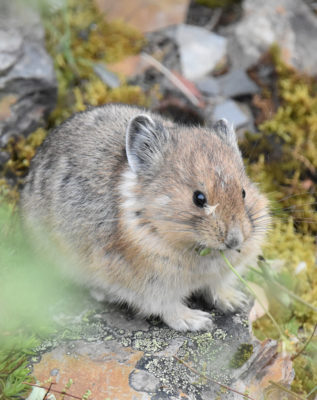I haven’t seen a Pika since I lived in Alberta many, many years ago. I didn’t see them very often back then; I mostly just heard them as they called and dove for cover. So I was very pleased to finally get some “up close and personal” looks at a Pika this summer on our vacation in the Rockies.
What’s a Pika?
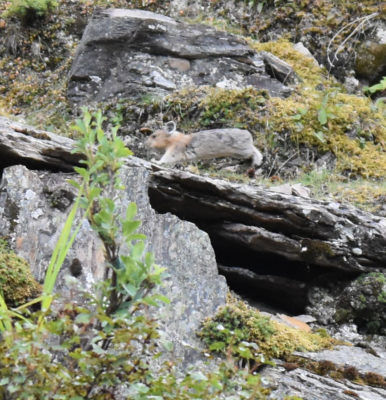
When this Pika leapt you could see its “hare shape.”
If you’ve never seen or heard one, you may be a bit fuzzy on what a Pika is. It’s not technically a rodent. It’s a lagomorph. Rabbits are lagomorphs too, if that helps; in fact Britannica says the word means “hare shaped.” One thing I didn’t know about rabbits is that they have two sets of top front incisors, one behind the other. I’m not completely clear if Pikas do too, but various sources say they have 4 front incisors so it’s probable.
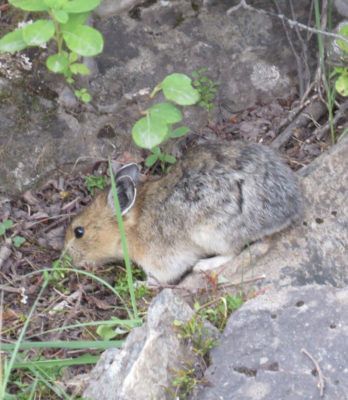
It’s easier to see the longer hind legs of this Pika that was grazing.
What Kind of Pikas Live In Banff National Park?
There are two types of Picas in Canada, according to the Canadian Encyclopedia. The ones in Banff are Rocky Mountain Pika, Ochotona princeps. I notice other sources call this same animal the American Pika.
Why Are They Called Pikas?
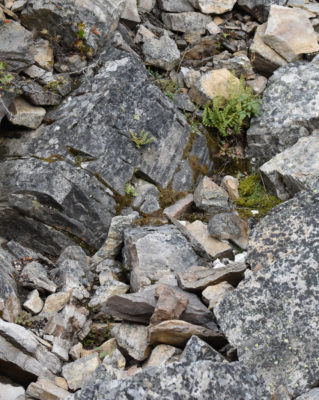
Can you spot the Pika? Their camo colours work well in the rocks. (Tip, look below the second largest clump of green.)
If you have to ask, you’ve never heard one. One of A Pika’s common calls sounds pretty much like the word “pee-ka” is pronounced.
Where Did We See Pikas in Banff National Park?
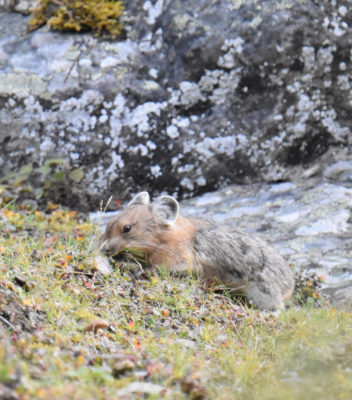
This Pika was gathering grass for its winter “haypile.”
American Pikas are fairly common throughout the Rocky Mountains. They usually live above the tree-line, though, where it’s cold enough for them. (Pikas are threatened by global warming because they literally cannot survive if they get too hot.) They eat plants and wildflowers but they prefer to live in holes and passageways beneath tumbled rocks. So they are commonly found near areas with rock falls and scree slopes that border on alpine meadows.
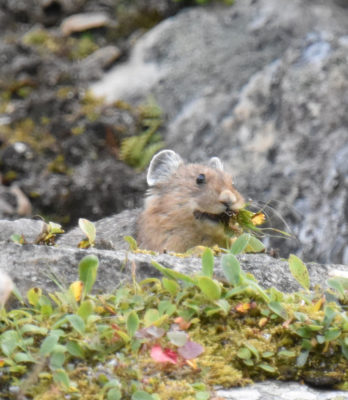
It didn’t just gather grass, though, it collected a variety of plants.
We had our Pika encounter at Moraine Lake. We were climbing the path to the top of the rock pile in the early evening in mid-August 2016 when we first heard then saw a Pika. It called, then ran from one location among the plants to another under a large overhanging rock. We saw it run back and forth between the two locations several times. We couldn’t see, though, whether it was cutting and gathering plants to store for winter in its “hay pile” or whether it was just nervous about staying out in the open.
Watching Pikas Pick Tasty Tidbits
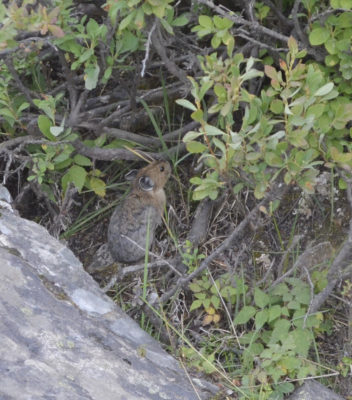
This Pika is almost sitting up while it chooses a twig to bite off this shrub.
When we climbed down the path, still in the sunshine but getting closer to evening, two Pikas popped up right near the path. One even posed briefly on a warm stone edging the route. We, and several other tourists, greatly appreciated this chance to see a Pika so closely.
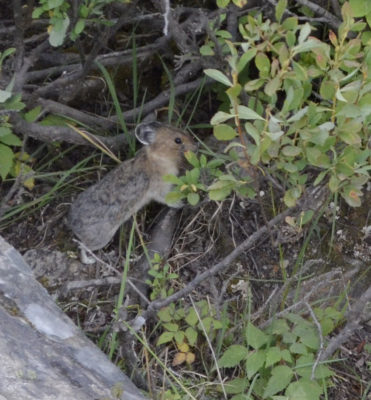
Although Pikas look round when they are staying still, they are fairly long-bodied when they need to reach something.
As we continued down, we saw a Pika eating various plants along the way. It even picked and ate some leaves off a small shrub.
No one tried to feed the Pikas, thankfully, and there was no sign that they were looking for handouts. They were calling to each other and nibbling and racing around. I don’t know if they are this active during the daytime when there are huge crowds at Moraine Lake. They may be if they are used to seeing people but I don’t know. (If you’ve visited at mid-day and seen them easily, please leave a comment to help other Pika-lovers know!) For sure this one was on the easiest to get to places where I’ve seen and heard Pikas.
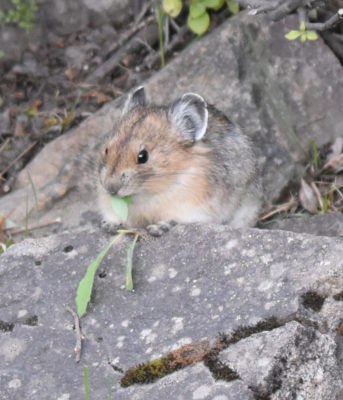
Pika – Chew. It’s eating the leaves off that small shrub. Photo Credit: MT with thanks.
We also heard Pikas near the top of Parker’s Ridge which is not a difficult hike but it does consist of a steady climb to a much higher elevation. The altitude can be a problem (causing headaches and or nausea) for some at Parker’s though. And we didn’t see the Pikas up close on that walk.
I’m glad we got to see some Pikas. Soon after we finished our vacation, the first flurries started falling on the tops of the Rockies. By now, at the end of September, I’m sure many of the Pika will be hard to find travelling under the rocks and snow to avoid predators as they visit their hay piles. (They don’t hibernate.) There are reports of Pika sun-bathing on warm rocks in winter, though, so maybe a late-fall hiker could be lucky enough to see one. I was happier to see one on a warm summer late afternoon with the only snow way up on top of the glaciers!
Related Reading
Join In
Do you think Pikas look more like Rabbits or Guinea Pigs? Have you seen some on your hikes? Please share your sighting with a comment.


